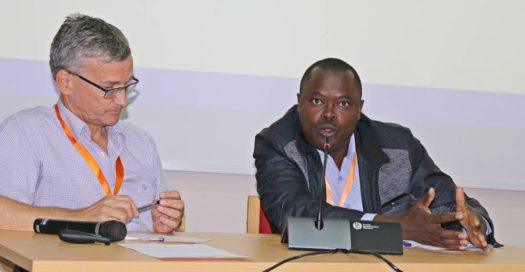
During this year’s annual Sweetpotato for Profit and Health Initiative meeting in Ethiopia, we held a panel discussion with senior managers of institutions engaged in sweetpotato pre-basic seed production participated. Here are three fascinating insights I gained from George Momanyi from the Kenya Plant Health Inspection Service (KEPHIS) and Stella Ennin from Crop Research Institute (CRI) Kumasi, Ghana.
1. There are examples of successful internal revenue generation by NARIs.

Stella noted that for CRI, commercialization of research results is mandatory, and there is considerable political capital involved. CRI has developed models for short term training targeted at extension staff from NGOs, private sector and farmers. They are also exploring licensing of varieties they have developed and seed multiplication including mango, rubber and pepper.
George told us about the Centre for Phytosanitary Excellence (COPE), which advertises and runs courses on a cost recovery basis. KEPHIS also has functions such as inspections, plant health sample analyses and tests for which they can levy charges to raise revenue. The charges for these services are gazetted, however, some of these charges do not make business sense. Therefore the services are not provided as a business, based on a cost-benefit analysis, but are used just to try to raise some revenue.
George highlighted that they have now adopted a business orientation for pre-basic sweetpotato seed production. They have developed a business plan, which they have marketed to management and are in the process of institutionalising. They discovered that they had exaggerated the cost of producing pre-basic seed, so are carrying out real time data collection, and hope that their pricing will be more realistic and thus more attractive to customers. George explained that they are also working on seed demand estimates, so that their production is aligned to an existing market. George is confident that the business plan is something that will make KEPHIS’ pre-basic seed production successful.
2. There is flexibility to allow internally generated revenues to be re-invested by the institution in future production activities.
There are different options available to them to manage the proceeds from pre-basic seed sales. For example, George explained that it was not necessary to open a separate bank account; instead at his station they opened a sub-ledger specifically for sweetpotato seed sales to be able to clearly track revenue. A management committee provides oversight to approve disbursements related to seed production costs.
3. Innovative profit sharing models which provide incentives to staff.
At CRI, there is a well-developed profit sharing model. Srini Rajendran (CIP Agricultural Economist) who has been supporting KEPHIS and CRI in real time cost data

collection asked Stella to give more details on how this model works. Stella explained that at the beginning of a project, those involved record their names and their contribution. She said, “we know who brought in the market, mostly it is breeders working in the field. The proportion (share of the profit) is regulated: 10% for the hunters, 30% for the team of workers who did the business, divided according to their percentage contribution, and 60% for institutional costs, which might include electricity and water.” Stella also pointed out that they have realised that some stages in their work flow have to be improved, because some business opportunities generated more profit if they were outsourced rather than implemented by CRI itself.
Finally, in the wrap-up, the panel chair, Graham Thiele, Director of the CGIAR Root, Tuber and Banana program, said that he was encouraged by the progress in using functional business tools, and excited that there is buy in from senior leadership. As Graham said: “the proof of success will be in the revenues generated.”
1 Comment. Leave new
[…] Read the post on the Sweetpotato Knowledge Portal website […]